Ask questions which are clear, concise and easy to understand.
Ask QuestionPosted by Dibya Ranjan Nayak 4 years, 7 months ago
- 2 answers
Gaurav Seth 4 years, 7 months ago
Let us assume that √5 is a rational number.
So it t can be expressed in the form p/q where p,q are co-prime integers and q≠0
⇒√5=p/q
On squaring both the sides we get,
⇒5=p²/q²
⇒5q²=p² —————–(i)
p²/5= q²
So 5 divides p
p is a multiple of 5
⇒p=5m
⇒p²=25m² ————-(ii)
From equations (i) and (ii), we get,
5q²=25m²
⇒q²=5m²
⇒q² is a multiple of 5
⇒q is a multiple of 5
Hence, p,q have a common factor 5. This contradicts our assumption that they are co-primes. Therefore, p/q is not a rational number
√5 is an irrational number
Posted by Priya Rana 4 years, 7 months ago
- 1 answers
Gaurav Seth 4 years, 7 months ago
In Fig. 13.12, you see the frame of a lampshade. It is to be covered with a decorative cloth. The frame has a base diameter of 20 cm and height of 30 cm. A margin of 2.5 cm is to be given for folding it over the top and bottom of the frame. Find how much cloth is required for covering the lampshade.

2r = 20 cm ⇒ r = 10 cm h = 30 cm
Cloth required = 2πr(h + 2.5 + 2.5)

= 2200 cm2.
Posted by Vèñkãťêšh ? 4 years, 7 months ago
- 3 answers
Yogita Ingle 4 years, 7 months ago
Let the measure of an angle be x, then the, measure of its complement is also x.
we know that the sum of the measures of complementary angles is 90˚.
Therefore, x + x = 90˚
2x = 90˚
x = 90/2 = 45˚
Posted by Riya Gujjar 4 years, 7 months ago
- 1 answers
Posted by Pawan Kumar 4 years, 7 months ago
- 2 answers
Posted by Amruta Shinde 4 years, 7 months ago
- 2 answers
Posted by Ayush Kumar 4 years, 7 months ago
- 1 answers
Gaurav Seth 4 years, 7 months ago
STEP 1: Focus on the leftmost terms of both the dividend and divisor.
STEP 2: Divide the leftmost term of the dividend by the leftmost term of the divisor.
STEP 3: Place the partial answer on top.
<figure>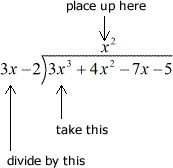 </figure>
</figure>
STEP 4: Use that partial answer, x2, to multiply into the divisor (3x−2).
STEP 5: Place their product under the dividend. Make sure to align them by similar terms.
<figure>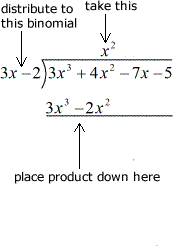 </figure>
</figure>
STEP 6: Perform subtraction by alternating the signs of the bottom polynomial.
<figure> </figure>
</figure>
STEP 7: Proceed with regular addition vertically. Again the first column cancels each other out. Looks like a pattern to me!
STEP 8: Carry down the next adjacent “unused” term of the dividend
<figure>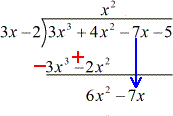 </figure>
</figure>
STEP 9: Take the leftmost term of the bottom polynomial, and divide by the leftmost term of the divisor.
STEP 10: Place the answer on top, as usual.
<figure>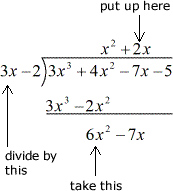 </figure>
</figure>
STEP 11: Okay, perform another multiplication by the partial answer 2x and divisor (3x−2). Bring the product below.
<figure>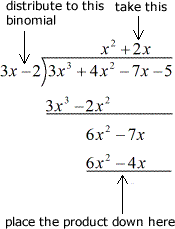 </figure>
</figure>
STEP 12: Perform subtraction by switching signs and proceed with normal addition.
STEP 13: Carry down the last unused term of the dividend. We’re almost there!
<figure>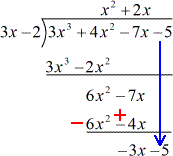 </figure>
</figure>
STEP 14: We are going up one more time. Divide the leading term of the bottom polynomial by the leading term of the divisor. Place the answer up there!
<figure>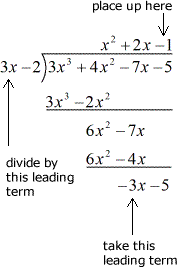 </figure>
</figure>
STEP 15: This is our “last trip” going down so we distribute the partial answer −1 by the divisor (3x−2), and placing the product “downstairs”.
<figure>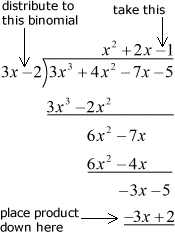 </figure>
</figure>
STEP 16: Finish this off by subtraction leaving as with a remainder of −7.
<figure>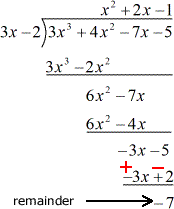 </figure>
</figure>
STEP 17: Write the final answer in the following form.
<figure> </figure>
<figure>
</figure>
<figure> </figure>
<hr />
</figure>
<hr />
Example 3: Divide using the long division method
<figure> </figure>
</figure>
Solution: If you observe the dividend, it is missing some powers of variable x which are x3 and x2. I need to insert zero coefficients as placeholders for missing powers of the variable. This is a critical part to correctly apply the procedures in long division.
So I rewrite the original problem as . Now all x‘s are accounted for!
<figure> </figure>
</figure>
STEP 1: Focus on the leading terms inside and outside the division symbol.
STEP 2: Divide the first term of the dividend by the first term of the divisor.
STEP 3: Position the partial answer on top.
<figure>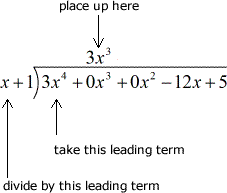 </figure>
</figure>
STEP 4: Use that partial answer placed on top, 3x2 to distribute into the divisor (x + 1).
STEP 5: Put the result under the dividend. Make sure to align them by similar terms.
<figure>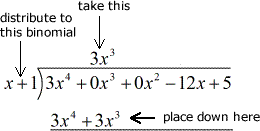 </figure>
</figure>
STEP 6: Subtract them together by making sure to switch the signs of the bottom terms before adding.
<figure>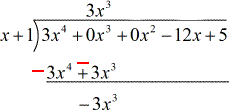 </figure>
</figure>
STEP 7: Carry down the next unused term of the dividend.
<figure>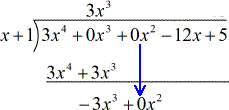 </figure>
</figure>
STEP 8: Looking at the bottom polynomial, −3x3 + 0x2, use the leading term −3x3 and divide it by the leading term of the divisor, x. Put the answer above the division symbol.
<figure>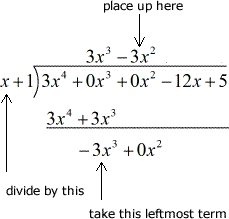 </figure>
</figure>
STEP 9: Multiply the answer you got previously, −3x3, and distribute into the divisor (x + 1).
STEP 10: Place the answer below then perform subtraction.
<figure>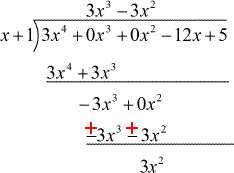 </figure>
</figure>
STEP 11: Bring down the next adjacent term of the dividend
<figure> </figure>
</figure>
STEP 12: Go up again by dividing the leading term below by the leading term of the divisor.
<figure>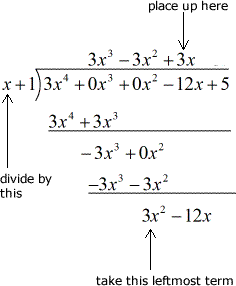 </figure>
</figure>
STEP 13: Go down by distributing the answer in partial quotient into the divisor, followed by subtraction.
I believe the pattern makes sense now. Yes?
<figure>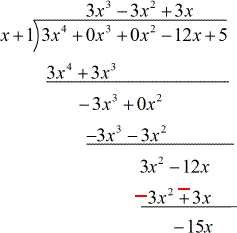 </figure>
</figure>
STEP 14: Carry down the last term of the dividend.
<figure>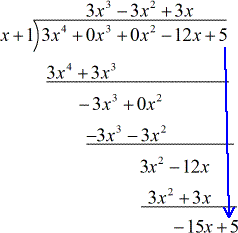 </figure>
</figure>
STEP 15: Go up again while performing division.
<figure>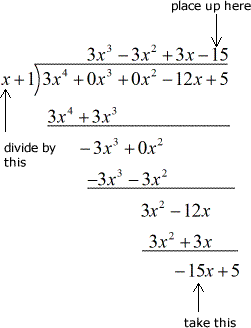 </figure>
</figure>
STEP 16: Go down again while performing multiplication.
<figure>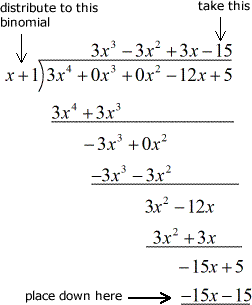 </figure>
</figure>
STEP 17: Do the final subtraction, and we are done! The remainder is equal to 20.
<figure>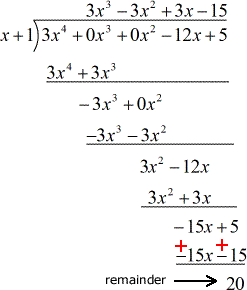 </figure>
</figure>
STEP 18: The final answer is
<figure> </figure>
<figure>
</figure>
<figure> </figure>
<hr />
</figure>
<hr />
Example 4: Divide the given polynomial using long division method
<figure> </figure>
</figure>
Solution: The dividend is obviously missing a lot of variable x. That means I need to insert zero coefficients in every missing power of the variable.
I need to rewrite the problem this way to include all exponents of x in descending order:
<figure> </figure>
</figure>
Remember the Main Steps in Long Division:
- When going up, we divide
- When going down, we distribute
- Subtract
- Carry down
- Repeat the process until done
Verify if the steps are being applied correctly in the example below.
<figure>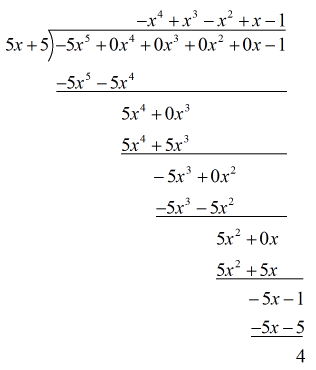 </figure>
</figure>
So the final answer is
<figure> </figure>
</figure>
Posted by Uttam Gautam 4 years, 7 months ago
- 1 answers
Posted by Mohammed Basil 4 years, 7 months ago
- 1 answers
Posted by Mohammed Basil 4 years, 7 months ago
- 1 answers
Gaurav Seth 4 years, 7 months ago
If the diagonals of a cyclic quadrilateral are diameters of the circle through the opposite vertices of the quadrilateral. Prove that the quadrilateral is a rectangle.
Answer
Here, ABCD is a cyclic quadrilateral in which AC and BD are diameters .
Since AC is a diameter.
∴ ∠ABC = ∠ADC = 90°
[∵ angle of a semicircle = 90°]
Also, BD is a diameter
∴∠BAD = ∠BCD = 90°
[∵ angle of a semicircle = 90°]
Now, all the angles of a cyclic quadrilateral ABCD are 90° each.
Hence, ABCD is a rectangle.
Posted by Saloni Gupta 4 years, 7 months ago
- 1 answers
Chaitanya Goravar 4 years, 7 months ago
Posted by Parul Saini 4 years, 7 months ago
- 4 answers
Sanskrati Kesharwani 4 years, 7 months ago
Posted by Prachi - 4 years, 7 months ago
- 5 answers
Yukti Verma 4 years, 7 months ago
Posted by Neeraja D 4 years, 7 months ago
- 2 answers
Yogita Ingle 4 years, 7 months ago
Modals (also called modal verbs, modal auxiliary verbs, modal auxiliaries) are special verbs which behave irregularly in English. They are different from normal verbs like “work, play, visit…” They give additional information about the function of the main verb that follows it. They have a great variety of communicative functions.
Priya Dagar 4 years, 7 months ago
Posted by Karan K U M A R 4 years, 7 months ago
- 4 answers
Posted by Siddhant Agarwal 4 years, 7 months ago
- 1 answers
Priya Dagar 4 years, 7 months ago
Posted by Aarti Raghuwanshi 4 years, 7 months ago
- 3 answers
Priya Dagar 4 years, 7 months ago
Queen 14 4 years, 7 months ago
Yogita Ingle 4 years, 7 months ago
Polynomials are expressions with one or more terms with a non-zero coefficient. A polynomial can have more than one term. In the polynomial, each expression in it is called a term.
Posted by Misba Aarfi 4 years, 7 months ago
- 1 answers
Priya Dagar 4 years, 7 months ago
Posted by Aarti Raghuwanshi 4 years, 7 months ago
- 3 answers
Мυѕкαи ? 4 years, 7 months ago
Posted by Devi Lal 4 years, 7 months ago
- 1 answers
Posted by Siddharth Maurya 4 years, 7 months ago
- 4 answers
Posted by Bhargavik Modi 4 years, 7 months ago
- 1 answers
Posted by Edward Padhaku 4 years, 7 months ago
- 1 answers
Yogita Ingle 4 years, 7 months ago
(5x)³+(2y)³+(z)³-30xyz
=(5x+2y+z)[(5x)²+(2y)²+(z)²-(5x×2y)-
=(2y×z)-(5x×z)]
= (5x+2y+z)(25x²+4y²+z² -10xy - 2yz- 5xz)
Posted by Abhi Jain 4 years, 7 months ago
- 1 answers
Meghna Thapar 4 years, 7 months ago
The hypotenuse of a right triangle is always the side opposite the right angle. It is the longest side in a right triangle. The other two sides are called the opposite and adjacent sides. These sides are labeled in relation to an angle. In geometry, an isosceles triangle is a triangle that has two sides of equal length. Sometimes it is specified as having exactly two sides of equal length, and sometimes as having at least two sides of equal length, the latter version thus including the equilateral triangle as a special case.
Posted by Faiz Faiz 4 years, 7 months ago
- 3 answers
X-O Harsh & Parveen 4 years, 7 months ago
Priya Rana 4 years, 7 months ago
Yogita Ingle 4 years, 7 months ago
A rational number between 3 and 4 =1/2(3+4)=7/2
Then 3<7/2<4
A rational number between 3 and 7/2
=1/23+7/2=1/2(3/1+72)
=1/2 (6+7)/2 =1/2+13/2=13/4
13/4, 7/2 are two rational number between 3 and 4
3<13/4<7/2<4.
Posted by Abhinav Sain 4 years, 7 months ago
- 4 answers
Posted by Murshitha Sheerin 4 years, 7 months ago
- 2 answers
Aryan Singh 4 years, 7 months ago
Samman Nirvan 4 years, 7 months ago
Posted by Dev Kumar 4 years, 7 months ago
- 1 answers
Yogita Ingle 4 years, 7 months ago
AE/AB = AF / AC and
< BAC = < EAF
Triangle ABC similar to triangle AEF (SAS)
by BPT
EF is parallel to BC
AB: AE = BC/EF
Let l be the length of AB
the AE = l/4
1:(1/4)= BC:2.8
= BC/2.8
BC = 2.8 X 4 = 11.2m
Posted by Anuj Kumar 4 years, 7 months ago
- 2 answers
Yogita Ingle 4 years, 7 months ago
Given ABCD is a rhombus.
Diagonals bisect each other perpendicularly.
Hence ∠BOC = 90°
Given ∠OCB = 40°
AD||BC and BD is the transversal
∴ ∠ADB = ∠DBC (Alternate angles)
Hence in right angled DBOC,
∠BOC + ∠OCB + ∠OBC = 180°
⇒ 90° + 40° + ∠OBC = 180°
⇒130° + ∠OBC = 180°
⇒ ∠OBC = 180° - 130° = 50°
But ∠OBC = ∠DBC
Therefore, ∠ADB = 50°

myCBSEguide
Trusted by 1 Crore+ Students

Test Generator
Create papers online. It's FREE.

CUET Mock Tests
75,000+ questions to practice only on myCBSEguide app
 myCBSEguide
myCBSEguide
Sanjay Kumar 4 years, 7 months ago
0Thank You